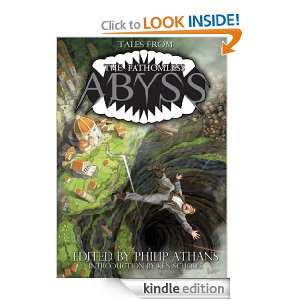
Back when I was first approached about the Fathomless Abyss, it involved an initial story and a later novella. Sure, I said, and whacked out a story for the first Fathomless Abyss book, TALES FROM THE FATHOMLESS ABYSS. It was “A Querulous Flute of Bone”, which I based on an O.Henry story, and which I think is one of my best stories to date. If you don’t believe me, spring for the 99 cent download and tell me if I’m wrong.
Then I started on the novella. The first thing I did was look up the length requirements. Wikipedia told me the official SFWA definition was 17500 to 40000 words. So just a long short story, right?
The problem with that was that…I write short. I excel at under 4000 words. So I turned again to a model. I’d been thinking about issues of addiction and so I decided I was going to write about that, and use William S. Burroughs’ JUNKY as my starting point. And I was going to throw in a touch of Lovecraft for spookiness and make the drug of my protagonist’s choice something a bit weird. And I wanted to reference some of the cool stuff the other Fathomless Abyss writers had added to the world.
I was telling a life story, from early days in an Abyssal village, through journeys to all sorts of points, culminating in some sort of…well, you know…climax. There was a chase for one thing, then another chase for what it turned into. I wanted to include something about the philosopher-king Nackle, whose teachings figured in “A Flute of Querulous Bone.” I wanted mushrooms and hallucinogenic wasp stings and pack llamas. I sketched out an outline and started writing. And I kept folding in stuff I wanted to include as I ran across it and then I reread Joe Lansdale’s THE COMPLETE DRIVE-IN and decided to not worry about being too weird and things all fell together…
And I became aware it was too long. Too, too, too long to finish on deadline. But I had the first half written and there was a good place midway to split the narrative, and so I said to Phil, “What if I do a pair of novellas, this first half, and then give you the second half for later release?”
So that’s what we have. I’m turning in A SEED ON THE WIND this time and A CAVERN RIPE WITH DREAMS will follow on its heels.
Wikipedia quotes Warren Cariou when discussing novella structure:
The novella is generally not as formally experimental as the long story and the novel can be, and it usually lacks the subplots, the multiple points of view, and the generic adaptability that are common in the novel. It is most often concerned with personal and emotional development rather than with the larger social sphere. The novella generally retains something of the unity of impression that is a hallmark of the short story, but it also contains more highly developed characterization and more luxuriant description.[7]
I know mine is focused on the development of a protagonist who I fear is somewhat unlovable. I’ve tried for interesting characterization and today I’m finishing up adding a layer of luxuriant description.
If you’ve come looking for advice on writing novellas, I’m not sure I have any. Perhaps you, the readers, can tell me what you think of them and what you’ve done when trying that form. I know Rachel Swirsky is a champ at writing them. What do you think – do you like novellas? What do or don’t you enjoy seeing in them? Can you think of anyone you think does them exceedingly well?






 If you’re looking for my roundup of F&SF posts by other writers, it’s
If you’re looking for my roundup of F&SF posts by other writers, it’s
5 Responses
Don’t know nothin’ about writin’ no novellas, but I am certainly looking forward to reading yours. A touch of Lovecraft improves any dish. Also, thanks for mentioning Lansdale’s Drive-In stuff a while back. I downloaded The Complete Drive-In and liked it a lot, although damned if I know why. It shouldn’t work but it does.
I think DRIVE IN is an absolutely fabulous book for conveying that the writer can go anywhere they like in a book and they can be as gonzo and bizarre as they like. Try to describe it to someone and it doesn’t sound all that great (except for the Popcorn King), but it is just so wonderful and weird while at the same time you care deeply about the characters.
I’m trying to think of other books that do that, which would make a great blog post.
Dhalgren maybe. At least I cared about the characters and you can’t deny it’s pretty weird. Of course I haven’t read the book you’re talking about (yet) so I may be off base, but there you go.
MKK
Let me quote the esteemed Michael Dirda who said in the Washington Post:
“Short stories contrive to use a single incident to illuminate a whole life: They aim for a short, sharp shock. Novels, those fabulously loose and baggy monsters, frequently transcribe entire biographies, reveal cross sections of society or show us the interaction of several generations. They contain multitudes. In between lies that most beautiful of fiction’s forms, the novella or nouvelle. Here, the writer aims for the compression that produces both intensity and resonance. By focusing on just two or three characters, the short novel can achieve a kind of artistic perfection, elegant in form yet wide in implication. The closest analogue may be Aeschylean tragedy – two actors on an almost bare stage, ripped by the torments of the human heart.”
Words to live by, my dear.
That’s awesome, Bud, I really like that!